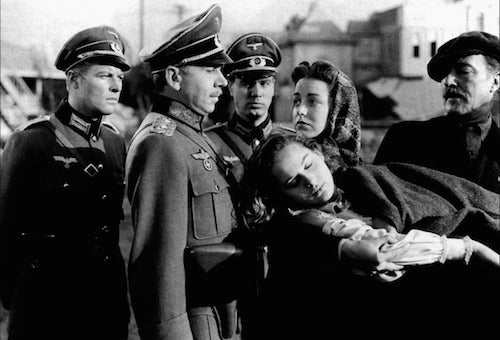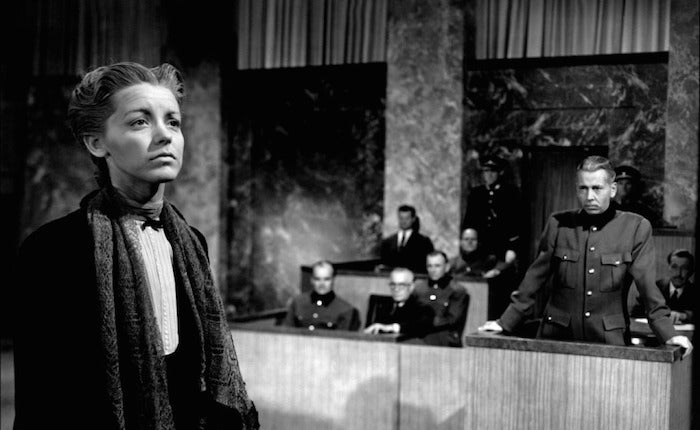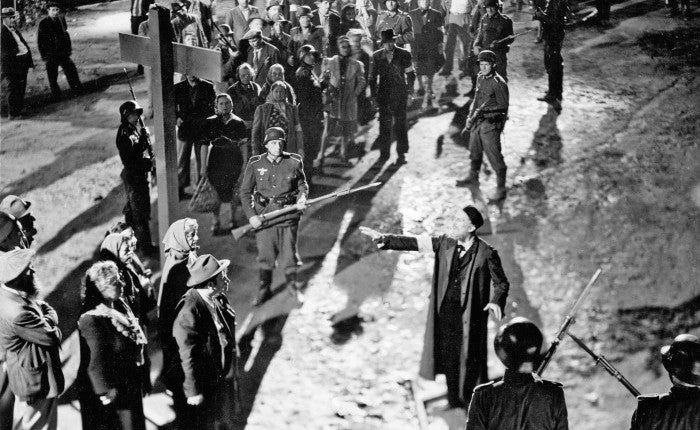
None Shall Escape (1944)
On May 25, the Los Angeles Jewish Film Festival closed with a rare screening of None Shall Escape (1944), an American anti-Nazi film. Hilary Helstein, founder and executive producer of the Jewish festival had invited me to interview Marsha Hunt, who stars in the film, but when she canceled due to ill health, Hilary and I did a Q&A about the film. As Director of As Seen Through These Eyes (2009), Ms. Helstein has conducted over 250 interviews with Holocaust survivors, so she was well prepared for a discussion about literally the only American film made during World War II to address the issue of the Shoah. Anti-Nazi films have been an interest of mine since my dissertation, and I had written an essay about None Shall Escape some time later. A large audience stayed engaged for the discussion after the film, but it surprised many that the plight of European Jewry was a taboo subject in official American WWII propaganda, given our knowledge today of the Holocaust.
In November 1943, Joseph Stalin, Winston Churchill, and Franklin D. Roosevelt signed the Moscow Declaration on German war crimes. At that moment, German armies were in retreat, while nightly Royal Air Force bombing raids were turning German cities into rubble. The uprising in the Warsaw ghetto had been crushed, but demonstrated Jewish resistance. For the first time in WWII, victory was in sight. President Roosevelt declared, “the ringleaders and their brutal henchmen must be named and apprehended, and tried in accordance with the judicial process of law.” The Moscow Declaration stated clearly that all alleged war criminals would be extradited to the countries in which they had committed war crimes. There was no mention of the death camps, even though the Roosevelt government knew about them. In other words, the specific nature of the ethnic genocide of 6 million Jewish human beings had not yet entered the discussion, nor would it, even after the war.

None Shall Escape (1944)
Less than three months after the war crimes trials declaration, Columbia Pictures released None Shall Escape, a film in which a German officer is led to the bar for atrocities committed in occupied Poland. The original film story had been written by two German émigrés, Alfred Neumann and Joseph Than, based on Neumann’s novel. Directed by Hungarian èmigrè André De Toth, the film’s narrative posited a theory of fascism, which attempted to explicate the rise of Nazism in terms of the wildgewordener Kleinbürger (crazed petite bourgeoisie) and a nation divided within itself, metamorphically embodied in the “Doppelgänger, two souls of the German bourgeoisie.”
In None Shall Escape, writer Alfred Neumann explicates Germany's destruction at the hands of fascism in terms of an Oedipal drama, a struggle between two brothers for the soul of their (surrogate) son. This dichotomy between the good father and the bad father, between a social democratic and an authoritarian fascist tradition in Germany situates Wilhelm and Carl as positive and negative poles of the petite bourgeoisie, represent a class divided in itself. Grimm's nephew, Wilhelm Jr., is educated in the Hitler Youth, once he is removed from the “bad” influence of his birth father. The film thus typifies one of the basic narratives of Hollywood anti-Nazi films, namely the destruction of the family. The doppelgänger motif appears here, as it does frequently in anti-Nazi films. Germany and the German bourgeoisie are presented as products of both an autocratic, undemocratic tradition, and as capable of a liberal-humanist society, embodied in “the other Germany.” The doppelgänger, of course, made its appearance in German romantic fiction, and in the Expressionist cinema of the Weimar Republic.
None Shall Escape (1944)
The film’s set piece is the massacre of the town’s Jewish population. Herded into cattle cars at the railroad station, for transport to the death camps, the Rabbi calls for mercy, then when he is rejected, for revolt. The entire congregation is machine-gunned, just as previously we have seen their degradation, when the Nazis move horses into the synagogue. The film not only visualizes the mass murder of Eastern European Jews, the first and only American film to do so until possibly the 1970s, but also pays tribute to Jewish resistance in Warsaw.
Many in the audience were surprised to hear that the Roosevelt administration made a decision even before the war began that saving Europe’s Jewish population could not be a war aim. Rather, only symbolic values, like democracy and the American way of life could be at stake, if much of the country was to be won over for a European war. Thus, in None Shall Escape the overthrow of church and state in a Polish town is contextualized in terms of American values, with only one scene depicting “the other.” And indeed, except for the town Rabbi, no other member of the Orthodox congregation is individualized, living and dying, instead, as an amorphous mass. And in a final irony, it is a cross that dominates the image of the Rabbi, as he utters is final words, not the single Star of David seen in the film.
After the War, America staged the Nuremberg Trials, for the top 20 in the Nazi hierarchy, then quickly forgot about German war crimes in the interest of creating an anti-Communist ally in Germany. Not until the 1960s would Germans begin to prosecute Holocaust perpetrators. Who would have imagined that prosecutions of Holocaust perpetrators would have to continue to the present day?
< Back to Archival Spaces blog






 Mobile Navigation
Mobile Navigation

